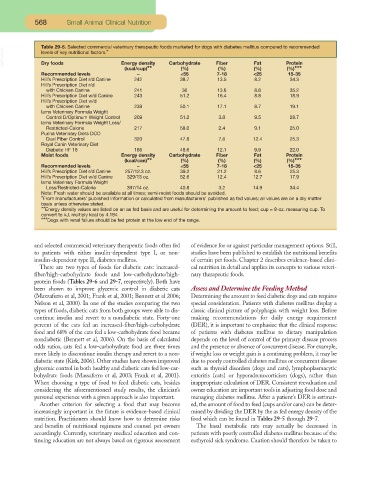Page 549 - Small Animal Clinical Nutrition 5th Edition
P. 549
568 Small Animal Clinical Nutrition
Table 29-5. Selected commercial veterinary therapeutic foods marketed for dogs with diabetes mellitus compared to recommended
VetBooks.ir
levels of key nutritional factors.*
Energy density
Dry foods
(%)***
(kcal/cup)** Carbohydrate Fiber Fat Protein
(%)
(%)
(%)
Recommended levels – ≤55 7-18 <25 15-35
Hill’s Prescription Diet r/d Canine 242 38.7 13.5 8.2 34.3
Hill’s Prescription Diet r/d
with Chicken Canine 241 36 13.6 8.8 35.2
Hill’s Prescription Diet w/d Canine 243 51.2 16.4 8.8 18.9
Hill’s Prescription Diet w/d
with Chicken Canine 239 50.1 17.1 8.7 19.1
Iams Veterinary Formula Weight
Control D/Optimum Weight Control 209 51.2 3.0 9.5 28.7
Iams Veterinary Formula Weight Loss/
Restricted-Calorie 217 58.0 2.4 9.1 25.0
Purina Veterinary Diets DCO
Dual Fiber Control 320 47.8 7.6 12.4 25.3
Royal Canin Veterinary Diet
Diabetic HF 18 186 48.6 12.1 9.9 22.0
Moist foods Energy density Carbohydrate Fiber Fat Protein
(kcal/can)** (%) (%) (%) (%)***
Recommended levels – ≤55 7-18 <25 15-35
Hill’s Prescription Diet r/d Canine 257/12.3 oz. 39.2 21.2 8.6 25.3
Hill’s Prescription Diet w/d Canine 329/13 oz. 52.6 12.4 12.7 17.9
Iams Veterinary Formula Weight
Loss/Restricted-Calorie 397/14 oz. 40.8 3.2 14.9 34.4
Note: Fresh water should be available at all times; semi-moist foods should be avoided.
*From manufacturers’ published information or calculated from manufacturers’ published as fed values; all values are on a dry matter
basis unless otherwise stated.
**Energy density values are listed on an as fed basis and are useful for determining the amount to feed; cup = 8-oz. measuring cup. To
convert to kJ, multiply kcal by 4.184.
***Dogs with renal failure should be fed protein at the low end of the range.
and selected commercial veterinary therapeutic foods often fed of evidence for or against particular management options. Still,
to patients with either insulin-dependent type I, or non- studies have been published to establish the nutritional benefits
insulin-dependent type II, diabetes mellitus. of certain pet foods. Chapter 2 describes evidence-based clini-
There are two types of foods for diabetic cats: increased- cal nutrition in detail and applies its concepts to various veteri-
fiber/high-carbohydrate foods and low-carbohydrate/high- nary therapeutic foods.
protein foods (Tables 29-6 and 29-7, respectively). Both have
been shown to improve glycemic control in diabetic cats Assess and Determine the Feeding Method
(Mazzaferro et al, 2001; Frank et al, 2001; Bennett et al 2006; Determining the amount to feed diabetic dogs and cats requires
Nelson et al, 2000). In one of the studies comparing the two special consideration. Patients with diabetes mellitus display a
types of foods, diabetic cats from both groups were able to dis- classic clinical picture of polyphagia with weight loss. Before
continue insulin and revert to a nondiabetic state. Forty-one making recommendations for daily energy requirement
percent of the cats fed an increased-fiber/high-carbohydrate (DER), it is important to emphasize that the clinical response
food and 68% of the cats fed a low-carbohydrate food became of patients with diabetes mellitus to dietary manipulation
nondiabetic (Bennett et al, 2006). On the basis of calculated depends on the level of control of the primary disease process
odds ratios, cats fed a low-carbohydrate food are three times and the presence or absence of concurrent disease. For example,
more likely to discontinue insulin therapy and revert to a non- if weight loss or weight gain is a continuing problem, it may be
diabetic state (Kirk, 2006). Other studies have shown improved due to poorly controlled diabetes mellitus or concurrent disease
glycemic control in both healthy and diabetic cats fed low-car- such as thyroid disorders (dogs and cats), lymphoplasmacytic
bohydrate foods (Massaferro et al, 2003; Frank et al, 2001). enteritis (cats) or hyperadrenocorticism (dogs), rather than
When choosing a type of food to feed diabetic cats, besides inappropriate calculation of DER. Consistent reevaluation and
considering the aforementioned study results, the clinician’s owner education are important tools in adjusting food dose and
personal experience with a given approach is also important. managing diabetes mellitus. After a patient’s DER is estimat-
Another criterion for selecting a food that may become ed, the amount of food to feed (cups and/or cans) can be deter-
increasingly important in the future is evidence-based clinical mined by dividing the DER by the as fed energy density of the
nutrition. Practitioners should know how to determine risks food which can be found in Tables 29-5 through 29-7.
and benefits of nutritional regimens and counsel pet owners The basal metabolic rate may actually be decreased in
accordingly. Currently, veterinary medical education and con- patients with poorly controlled diabetes mellitus because of the
tinuing education are not always based on rigorous assessment euthyroid sick syndrome. Caution should therefore be taken to

